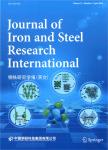Macro-and Microstructure Evolution of 5CrNiMo Steel Ingots during Electroslag Remelting Process
Macro-and Microstructure Evolution of 5CrNiMo Steel Ingots during Electroslag Remelting Process作者机构:College of Mechanical and Electronic EngineeringHohai University Xinya Special Steel Forging Co.Ltd. College of Mechanical and Electronic EngineeringNanchang University
出 版 物:《Journal of Iron and Steel Research International》 (Journal of Iron and Steel Research, International)
年 卷 期:2014年第21卷第7期
页 面:644-652页
核心收录:
学科分类:0806[工学-冶金工程] 08[工学] 0805[工学-材料科学与工程(可授工学、理学学位)] 080601[工学-冶金物理化学] 0703[理学-化学] 0702[理学-物理学] 0801[工学-力学(可授工学、理学学位)]
基 金:Item Sponsored by National Natural Science Foundation of China(51165030)
主 题:electroslag remelting macrostructure microstructure remelting rate secondary dendrite arm spacing
摘 要:A comprehensive mathematical model was established and used to simulate the macro and microstructure evolution during the production process of 5CrNiMo steel ingot by electroslag remelting (ESR) method. Along the ingot height, the macrostructure distribution characteristics changed from vertical, fine columnar grains to tilted, coarse columnar grains, and this transformation process occurred at the very beginning of ESR. In the cross section of the ingot, there were three grain morphology regions and two grain type transition regions from the outside to the center of the ingot. These regions were the fine columnar grain region, columnar competitive growth transition re gion, coarse columnar grain region, columnar to equiaxed grain transition (CET) region, and coarse equiaxed grain region. The influence of the remelting rate on the macrostructure and mlcrostructure was investigated using a series of experiments and simulations. The results showed that a low remelting rate could produce a small grain growth angle (GGA) ; the average secondary dendrite arm spacing (SDAS) firstly decreased and then increased as the remelting rate increased. An excessively high or low remelting rate can increase the GGA and average SDAS in ingots. Thus, the remelting rate should be controlled within a suitable range to reduce composition microsegregation and microshrinkage in the ingot to produce an ESR ingot with satisfactory hot forging performance.



